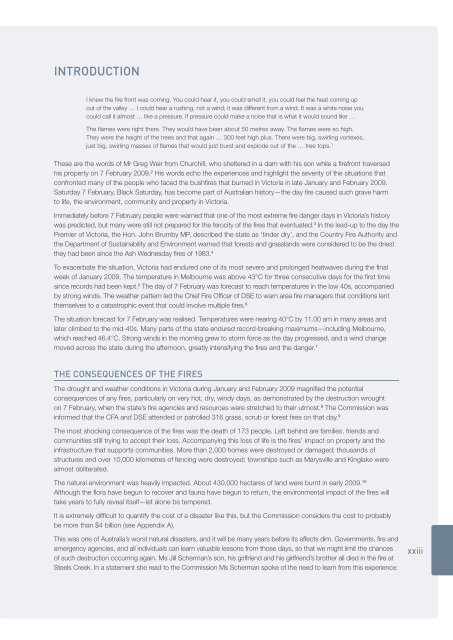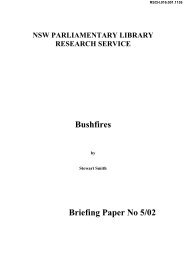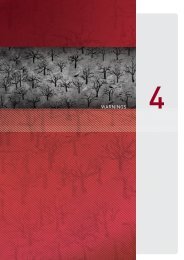The Fires and The Fire-relaTed deaThs - 2009 Victorian Bushfires ...
The Fires and The Fire-relaTed deaThs - 2009 Victorian Bushfires ...
The Fires and The Fire-relaTed deaThs - 2009 Victorian Bushfires ...
You also want an ePaper? Increase the reach of your titles
YUMPU automatically turns print PDFs into web optimized ePapers that Google loves.
Introduction<br />
I knew the fire front was coming. You could hear it, you could smell it, you could feel the heat coming up<br />
out of the valley … I could hear a rushing, not a wind; it was different from a wind. It was a white noise you<br />
could call it almost … like a pressure. If pressure could make a noise that is what it would sound like …<br />
<strong>The</strong> flames were right there. <strong>The</strong>y would have been about 50 metres away. <strong>The</strong> flames were so high.<br />
<strong>The</strong>y were the height of the trees <strong>and</strong> that again … 300 feet high plus. <strong>The</strong>re were big, swirling vortexes,<br />
just big, swirling masses of flames that would just burst <strong>and</strong> explode out of the … tree tops. 1<br />
<strong>The</strong>se are the words of Mr Greg Weir from Churchill, who sheltered in a dam with his son while a firefront traversed<br />
his property on 7 February <strong>2009</strong>. 2 His words echo the experiences <strong>and</strong> highlight the severity of the situations that<br />
confronted many of the people who faced the bushfires that burned in Victoria in late January <strong>and</strong> February <strong>2009</strong>.<br />
Saturday 7 February, Black Saturday, has become part of Australian history—the day fire caused such grave harm<br />
to life, the environment, community <strong>and</strong> property in Victoria.<br />
Immediately before 7 February people were warned that one of the most extreme fire danger days in Victoria’s history<br />
was predicted, but many were still not prepared for the ferocity of the fires that eventuated. 3 In the lead-up to the day the<br />
Premier of Victoria, the Hon. John Brumby MP, described the state as ‘tinder dry’, <strong>and</strong> the Country <strong>Fire</strong> Authority <strong>and</strong><br />
the Department of Sustainability <strong>and</strong> Environment warned that forests <strong>and</strong> grassl<strong>and</strong>s were considered to be the driest<br />
they had been since the Ash Wednesday fires of 1983. 4<br />
To exacerbate the situation, Victoria had endured one of its most severe <strong>and</strong> prolonged heatwaves during the final<br />
week of January <strong>2009</strong>. <strong>The</strong> temperature in Melbourne was above 43°C for three consecutive days for the first time<br />
since records had been kept. 5 <strong>The</strong> day of 7 February was forecast to reach temperatures in the low 40s, accompanied<br />
by strong winds. <strong>The</strong> weather pattern led the Chief <strong>Fire</strong> Officer of DSE to warn area fire managers that conditions lent<br />
themselves to a catastrophic event that could involve multiple fires. 6<br />
<strong>The</strong> situation forecast for 7 February was realised. Temperatures were nearing 40°C by 11.00 am in many areas <strong>and</strong><br />
later climbed to the mid-40s. Many parts of the state endured record-breaking maximums—including Melbourne,<br />
which reached 46.4°C. Strong winds in the morning grew to storm force as the day progressed, <strong>and</strong> a wind change<br />
moved across the state during the afternoon, greatly intensifying the fires <strong>and</strong> the danger. 7<br />
<strong>The</strong> consequences of the fires<br />
<strong>The</strong> drought <strong>and</strong> weather conditions in Victoria during January <strong>and</strong> February <strong>2009</strong> magnified the potential<br />
consequences of any fires, particularly on very hot, dry, windy days, as demonstrated by the destruction wrought<br />
on 7 February, when the state’s fire agencies <strong>and</strong> resources were stretched to their utmost. 8 <strong>The</strong> Commission was<br />
informed that the CFA <strong>and</strong> DSE attended or patrolled 316 grass, scrub or forest fires on that day. 9<br />
<strong>The</strong> most shocking consequence of the fires was the death of 173 people. Left behind are families, friends <strong>and</strong><br />
communities still trying to accept their loss. Accompanying this loss of life is the fires’ impact on property <strong>and</strong> the<br />
infrastructure that supports communities. More than 2,000 homes were destroyed or damaged; thous<strong>and</strong>s of<br />
structures <strong>and</strong> over 10,000 kilometres of fencing were destroyed; townships such as Marysville <strong>and</strong> Kinglake were<br />
almost obliterated.<br />
<strong>The</strong> natural environment was heavily impacted. About 430,000 hectares of l<strong>and</strong> were burnt in early <strong>2009</strong>. 10<br />
Although the flora have begun to recover <strong>and</strong> fauna have begun to return, the environmental impact of the fires will<br />
take years to fully reveal itself—let alone be tempered.<br />
It is extremely difficult to quantify the cost of a disaster like this, but the Commission considers the cost to probably<br />
be more than $4 billion (see Appendix A).<br />
This was one of Australia’s worst natural disasters, <strong>and</strong> it will be many years before its effects dim. Governments, fire <strong>and</strong><br />
emergency agencies, <strong>and</strong> all individuals can learn valuable lessons from those days, so that we might limit the chances<br />
of such destruction occurring again. Ms Jill Scherman’s son, his girlfriend <strong>and</strong> his girlfriend’s brother all died in the fire at<br />
Steels Creek. In a statement she read to the Commission Ms Scherman spoke of the need to learn from this experience:<br />
xxiii
















